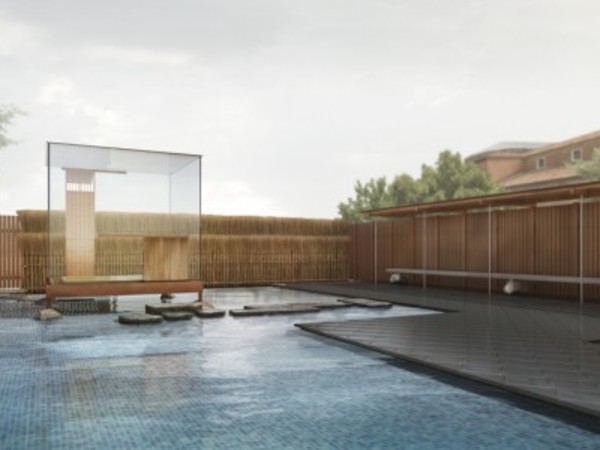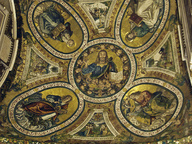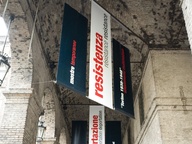Hiroshi Sugimoto. Glass Tea House Mondrian

Hiroshi Sugimoto. Glass Tea House Mondrian, Le Stanze del Vetro, Isola di San Giorgio Maggiore, Venezia
From 06 Giugno 2014 to 12 Ottobre 2014
Venice
Place: Le Stanze del Vetro
Address: Isola di San Giorgio Maggiore 1
Telefono per informazioni: +39 041 5229138
E-Mail info: ufficiostampa@lestanzedelvetro.it
Official site: http://www.lestanzedelvetro.it
The Japanese artist Hiroshi Sugimoto made ??his first architectural work Le Stanze del Vetro on Island of San Giorgio Maggiore in Venice.
On June 6 2014 on the Island of San Giorgio Maggiore in Venice as part of the activities organized by Le Stanze del Vetro , open to the public "Glass Tea House Mondrian", a temporary pavilion created by the artist and photographer Hiroshi Sugimoto. Known throughout the world for his shots in black and white, Sugimoto for the first time in Venice designing an architectural structure.
"Glass Tea House Mondrian" is produced by Le Stanze del Vetro - joint project of the Fondazione Cini and Pentagram Stiftung - with the support of Sumitomo Forestry Co. Ltd., and Bisazza Foundation, and in collaboration with Asahi -Wall Building Co. Ltd. a special thanks is devoted to the study Cattaruzza Millosevich Associates Architects for following each step of the design and construction of this pavilion.
In conjunction with the "Glass Tea House Mondrian", the Fondazione Bevilacqua la Masa at the site of Tito's Palace in Venice, dedicated to Hiroshi Sugimoto's photographs of unprecedented anthology dedicated to architecture: the exhibition, with the draft of Le Stanze del Vetro, will this ever international player and his commitment to the built environment a key point of the season in Venice, in harmony with the new extended configuration of the Architecture Biennale.
The work "Glass Tea House Mondrian" is a new initiative from those presented so far from Le Stanze del Vetro, broadening the horizons of the project and involving internationally renowned artists to design pavilions or installations for the garden in front of Le Stanze del Vetro, the Series model of the Serpentine Gallery Pavilion in London.
"Glass Tea House Mondrian" by Hiroshi Sugimoto is inspired by the tradition of the Japanese tea ceremony, as it was reformed by the master Sen no Rikyu. The pavilion consists of two main components, one short and one indoor.
The structure uncovered ( about 40 meters long and 12.5 meters wide ) winds through a path that includes a long pool of water, which leads the visitor into a glass cube (2.5 x 2, 5 meters ), where on a regular basis, you will offciata a Japanese tea ceremony. The glass cube welcome, together with the master of ceremonies, two visitors at a time, while the public may attend and take part in the ceremony gathering at the sides of the glass cube.
The tools that will be used for the tea ceremony are designed by Hiroshi Sugimoto and produced by artisans in Kyoto.
The flexible structure of the pavilion and its temporary nature, will also transform that space, so far unused , in a versatile , able to accommodate meetings and debates, and encourage visitors to freely determine their own experience with the pavilion. The innovation of "Glass Tea House Mondrian" lies in its ability to suggest a space for exhibiting and experiencing architecture, where the pavilion itself becomes exposure - innovation to which is added the autonomy of the artist to propose a theme and a project free from restrictions, but rather open to the possibility of experimenting with shapes , place, building technologies and materials.
In the frame of the Island of San Giorgio Maggiore, the "Glass Tea House Mondrian" Sugimoto also acquires a symbolic value by encouraging the visitor to interact freely with the place, and also requiring you to find the right balance between personal and artifice architectural and the natural environment that surrounds it.
"Glass Tea House Mondrian" builds a strong dialogue between interior and exterior, nature and artifice, closed and open, light and heavy, water and land, a relationship that results in the use of timber from Japan - for the external path -, mosaic - for the hot water - and glass - for the deputy to the experience of Japanese tradition.
The external structure is built entirely of cedar wood from Japan, and realized by Sumitomo Forestry Co. Ltd. Chosen by Hiroshi Sugimoto for their efforts in contributing to the reconstruction of the areas devastated by the T?hoku earthquake and tsunami of 2011, the contribution of Sumitomo Forestry has been instrumental in the construction of "Glass Tea House Mondrian" and the external enclosure, which is inspired volunteered at the Shrine of Ise. This project , without the help of Sumitomo Forestry would have been impossible to achieve. Sumitomo Forestry is a company that has made use of wood for residential construction and not ( such as schools or hospitals ), one of its strengths, demonstrating the architectural potential of this natural resource, a renewable resource and with zero impact on environment.
The water tank, which takes the visitor to the end point of the pavilion and then also at its height, is made ??possible thanks to the collaboration with Bisazza Foundation. The eponymous company, based in Vicenza, is specialized in the production of glass mosaic for interior and exterior solutions.
The glass cube, finally, is the work of the company Asahi -Wall Building Co. Ltd, a leader in the design of architectural glass and engineering solutions in building glass facade or structural components of buildings.
Also for this project continue educational activities and guided tours organized by Le Stanze del Vetro and edited by Artsystem . All the educational proposals are free, bookable toll free 800 662 477 (from Monday to Friday from 10 am to 5 pm) or by sending an email to: artsystem@artsystem.it
On June 6 2014 on the Island of San Giorgio Maggiore in Venice as part of the activities organized by Le Stanze del Vetro , open to the public "Glass Tea House Mondrian", a temporary pavilion created by the artist and photographer Hiroshi Sugimoto. Known throughout the world for his shots in black and white, Sugimoto for the first time in Venice designing an architectural structure.
"Glass Tea House Mondrian" is produced by Le Stanze del Vetro - joint project of the Fondazione Cini and Pentagram Stiftung - with the support of Sumitomo Forestry Co. Ltd., and Bisazza Foundation, and in collaboration with Asahi -Wall Building Co. Ltd. a special thanks is devoted to the study Cattaruzza Millosevich Associates Architects for following each step of the design and construction of this pavilion.
In conjunction with the "Glass Tea House Mondrian", the Fondazione Bevilacqua la Masa at the site of Tito's Palace in Venice, dedicated to Hiroshi Sugimoto's photographs of unprecedented anthology dedicated to architecture: the exhibition, with the draft of Le Stanze del Vetro, will this ever international player and his commitment to the built environment a key point of the season in Venice, in harmony with the new extended configuration of the Architecture Biennale.
The work "Glass Tea House Mondrian" is a new initiative from those presented so far from Le Stanze del Vetro, broadening the horizons of the project and involving internationally renowned artists to design pavilions or installations for the garden in front of Le Stanze del Vetro, the Series model of the Serpentine Gallery Pavilion in London.
"Glass Tea House Mondrian" by Hiroshi Sugimoto is inspired by the tradition of the Japanese tea ceremony, as it was reformed by the master Sen no Rikyu. The pavilion consists of two main components, one short and one indoor.
The structure uncovered ( about 40 meters long and 12.5 meters wide ) winds through a path that includes a long pool of water, which leads the visitor into a glass cube (2.5 x 2, 5 meters ), where on a regular basis, you will offciata a Japanese tea ceremony. The glass cube welcome, together with the master of ceremonies, two visitors at a time, while the public may attend and take part in the ceremony gathering at the sides of the glass cube.
The tools that will be used for the tea ceremony are designed by Hiroshi Sugimoto and produced by artisans in Kyoto.
The flexible structure of the pavilion and its temporary nature, will also transform that space, so far unused , in a versatile , able to accommodate meetings and debates, and encourage visitors to freely determine their own experience with the pavilion. The innovation of "Glass Tea House Mondrian" lies in its ability to suggest a space for exhibiting and experiencing architecture, where the pavilion itself becomes exposure - innovation to which is added the autonomy of the artist to propose a theme and a project free from restrictions, but rather open to the possibility of experimenting with shapes , place, building technologies and materials.
In the frame of the Island of San Giorgio Maggiore, the "Glass Tea House Mondrian" Sugimoto also acquires a symbolic value by encouraging the visitor to interact freely with the place, and also requiring you to find the right balance between personal and artifice architectural and the natural environment that surrounds it.
"Glass Tea House Mondrian" builds a strong dialogue between interior and exterior, nature and artifice, closed and open, light and heavy, water and land, a relationship that results in the use of timber from Japan - for the external path -, mosaic - for the hot water - and glass - for the deputy to the experience of Japanese tradition.
The external structure is built entirely of cedar wood from Japan, and realized by Sumitomo Forestry Co. Ltd. Chosen by Hiroshi Sugimoto for their efforts in contributing to the reconstruction of the areas devastated by the T?hoku earthquake and tsunami of 2011, the contribution of Sumitomo Forestry has been instrumental in the construction of "Glass Tea House Mondrian" and the external enclosure, which is inspired volunteered at the Shrine of Ise. This project , without the help of Sumitomo Forestry would have been impossible to achieve. Sumitomo Forestry is a company that has made use of wood for residential construction and not ( such as schools or hospitals ), one of its strengths, demonstrating the architectural potential of this natural resource, a renewable resource and with zero impact on environment.
The water tank, which takes the visitor to the end point of the pavilion and then also at its height, is made ??possible thanks to the collaboration with Bisazza Foundation. The eponymous company, based in Vicenza, is specialized in the production of glass mosaic for interior and exterior solutions.
The glass cube, finally, is the work of the company Asahi -Wall Building Co. Ltd, a leader in the design of architectural glass and engineering solutions in building glass facade or structural components of buildings.
Also for this project continue educational activities and guided tours organized by Le Stanze del Vetro and edited by Artsystem . All the educational proposals are free, bookable toll free 800 662 477 (from Monday to Friday from 10 am to 5 pm) or by sending an email to: artsystem@artsystem.it
SCARICA IL COMUNICATO IN PDF
COMMENTI

-
 Dal 31 gennaio 2024 al 04 maggio 2025
Fermo | Palazzo dei Priori
Dal 31 gennaio 2024 al 04 maggio 2025
Fermo | Palazzo dei Priori
-
 Dal 20 dicembre 2024 al 04 maggio 2025
Fermo | Palazzo dei Priori
Dal 20 dicembre 2024 al 04 maggio 2025
Fermo | Palazzo dei Priori
-
 Dal 20 dicembre 2024 al 04 maggio 2024
Gorizia | Palazzo Attems Petzenstein
Dal 20 dicembre 2024 al 04 maggio 2024
Gorizia | Palazzo Attems Petzenstein
-
 Dal 18 dicembre 2024 al 18 dicembre 2024
Venezia | Museo Correr
Dal 18 dicembre 2024 al 18 dicembre 2024
Venezia | Museo Correr
-
 Dal 14 dicembre 2024 al 02 marzo 2025
Palermo | Palazzo Abatellis
Dal 14 dicembre 2024 al 02 marzo 2025
Palermo | Palazzo Abatellis
-
 Dal 12 dicembre 2024 al 23 febbraio 2025
Roma | Palazzo Altemps
Dal 12 dicembre 2024 al 23 febbraio 2025
Roma | Palazzo Altemps


